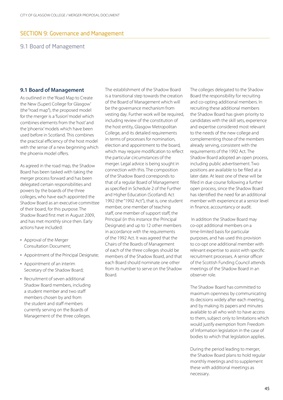
CITY OF GLASGOW COLLEGE / MERGER PROPOSAL DOCUMENT
45
9.1 Board of Management
As outlined in the 'Road Map to Create
the New (Super) College for Glasgow'
(the "road map"), the proposed model
for the merger is a 'fusion' model which
combines elements from the 'host' and
the 'phoenix' models which have been
used before in Scotland. This combines
the practical ei ciency of the host model
with the sense of a new beginning which
the phoenix model of ers.
As agreed in the road map, the Shadow
Board has been tasked with taking the
merger process forward and has been
delegated certain responsibilities and
powers by the boards of the three
colleges, who have each appointed the
Shadow Board as an executive committee
of their board, for this purpose. The
Shadow Board i rst met in August 2009,
and has met monthly since then. Early
actions have included:
Approval of the Merger
Consultation Document;
Appointment of the Principal Designate;
Appointment of an interim
Secretary of the Shadow Board;
Recruitment of seven additional
Shadow Board members, including
a student member and two staf
members chosen by and from
the student and staf members
currently serving on the Boards of
Management of the three colleges.
•
•
•
•
The establishment of the Shadow Board
is a transitional step towards the creation
of the Board of Management which will
be the governance mechanism from
vesting day. Further work will be required,
including review of the constitution of
the host entity, Glasgow Metropolitan
College, and its detailed requirements
in terms of processes for nomination,
election and appointment to the board,
which may require modii cation to rel ect
the particular circumstances of the
merger. Legal advice is being sought in
connection with this. The composition
of the Shadow Board corresponds to
that of a regular Board of Management
as specii ed in Schedule 2 of the Further
and Higher Education (Scotland) Act
1992 (the "1992 Act"), that is, one student
member, one member of teaching
staf , one member of support staf , the
Principal (in this instance the Principal
Designate) and up to 12 other members
in accordance with the requirements
of the 1992 Act. It was agreed that the
Chairs of the Boards of Management
of each of the three colleges should be
members of the Shadow Board, and that
each Board should nominate one other
from its number to serve on the Shadow
Board.
The colleges delegated to the Shadow
Board the responsibility for recruiting
and co-opting additional members. In
recruiting these additional members
the Shadow Board has given priority to
candidates with the skill sets, experience
and expertise considered most relevant
to the needs of the new college and
complementing those of the members
already serving, consistent with the
requirements of the 1992 Act. The
Shadow Board adopted an open process,
including public advertisement. Two
positions are available to be i lled at a
later date. At least one of these will be
i lled in due course following a further
open process, since the Shadow Board
has identii ed the need for an additional
member with experience at a senior level
in i nance, accountancy or audit.
In addition the Shadow Board may
co-opt additional members on a
time-limited basis for particular
purposes, and has used this provision
to co-opt one additional member with
relevant expertise to assist with specii c
recruitment processes. A senior oi cer
of the Scottish Funding Council attends
meetings of the Shadow Board in an
observer role.
The Shadow Board has committed to
maximum openness by communicating
its decisions widely after each meeting,
and by making its papers and minutes
available to all who wish to have access
to them, subject only to limitations which
would justify exemption from Freedom
of Information legislation in the case of
bodies to which that legislation applies.
During the period leading to merger,
the Shadow Board plans to hold regular
monthly meetings and to supplement
these with additional meetings as
necessary.
SECTION 9: Governance and Management
9.1 Board of Management